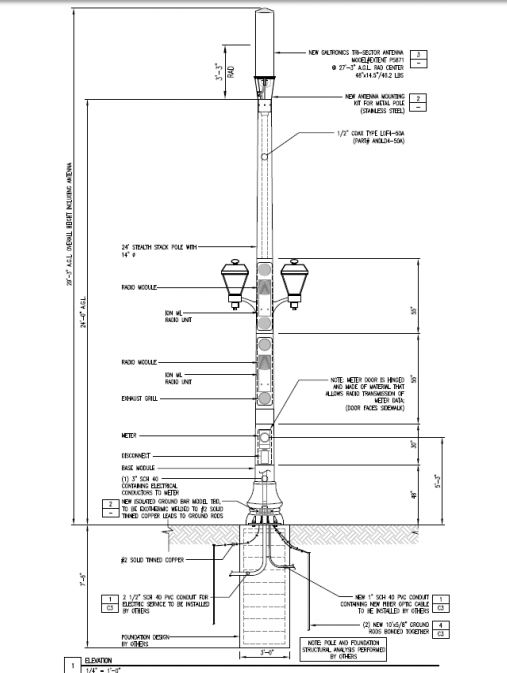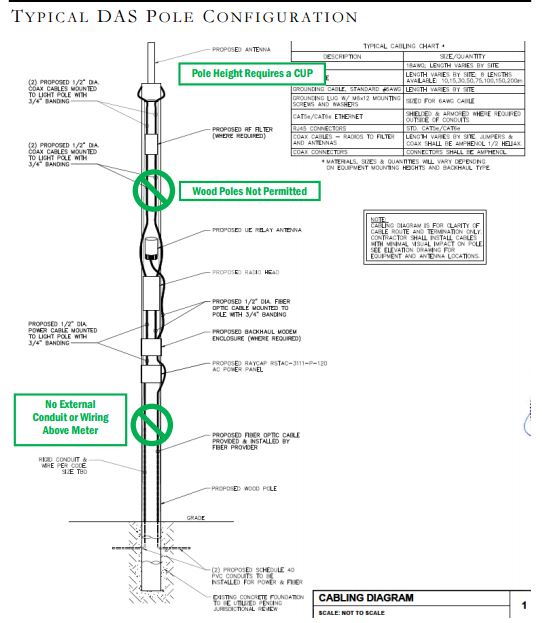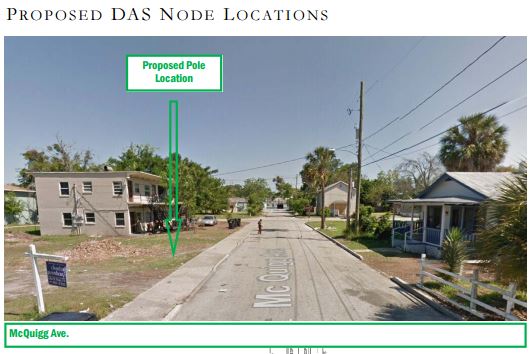Tale of Two Small Cell Proposals – Crown Castle vs. Mobilitie
The City of Orlando, Florida recently received two separate applications for two separate sets of DAS nodes and/or small cells. The applications were submitted by Crown Castle and Telemobilitie, both of whom purport to request planning approval for new poles and/or the replacement of existing poles. We believe that Telemobilitie is a “Doing Business As” name for Mobilitie – the applicant who submitted the plans to the City on behalf of Telemobilitie has a LinkedIn page indicating she works for Mobilitie, a company which is purported to be assisting Sprint with the development of 70,000 “mini-macro” small cell sites. As previously mentioned Mobilitie has set up a number of LLCs with different names, for some unknown reason. An examination of the two applications illustrates the inherent issues that companies like Mobilitie will face when proposing new 70′ -100′ structures for the public rights-of-way, as opposed to the 35′ pole replacements being proposed by Crown Castle. Here are the two planning applications and summary details of each.
Crown Castle’s Proposed 35′ Poles
Crown Castle Small Cell Plan Staff Report – submitted for 8 locations in downtown Orlando. Six of the proposed poles would replace existing utility poles owned by the Orlando Utility Commission, and 2 new poles would be constructed (and owned) by Crown Castle. Crown Castle is proposing new or replacement poles that are all under 35′ in height, which therefore negates the necessity of a Conditional Use permit in the City of Orlando. Below is a snapshot of one of the drawings for a small cell. It is not particularly appealing as a light pole, but certainly fairly attractive as a small cell. Note the placement of an electric meter on the base of the pole.

Mobilitie’s Proposed 70′ Poles
Telemobilitie Small Cell Staff Review – submitted for 2 locations near downtown Orlando for the installation of two 70′ wood poles. Mobilitie submitted these two applications despite the Code’s explicit terms that a Conditional Use permit is required for all DAS node poles or small cell poles that are taller than 35′. Furthermore, the Code requires that the poles be galvanized metal, yet Mobilitie proposed wood poles. If you examine the Mobilitie proposal, you can see that they are including two antennas on the pole: one at the top for standard cellular/PCS/AWS/2.5 use, and one down the pole for UE relay or LTE backhaul (whereby Sprint will be using their own spectrum for wireless backhaul).

One of the two poles proposed is to be constructed near an existing parking garage and is likely appropriate for the area. The second is to be built in a lower end residential area where the buildings are less than a few stories tall. It is hard to imagine that a 70′ pole will be approved in this location, especially when there is a 30′ pole just across the road that could have been replaced much less conspicuously. The equipment appears to be attached to the exterior of the pole instead of being built within the pole, a fact which the City of Orlando properly identified as an issue in their evaluation.

How are these applications being treated?
So in reviewing the planning staff recommendations in each of these Appearance Review Board reviews, you can see how these two similar applications will end up being treated differently. Because the Crown Castle poles are under 35′ in height, the City of Orlando Appearance Review Board has recommended approval (with conditions including relocation of some poles to nearby locations) for all 8 poles and has reviewed a specific design from Crown for future poles to make it easier and quicker for future approval. Conversely, the City of Orlando is requiring that both Mobilitie poles obtain a Conditional Use approval, which will entail an application and a formal review and hearing process. A Conditional Use review will require notice to nearby residents and a public hearing, which reduces the probability that a pole will be approved.
Another interesting component: if you examine the comments in the Mobilitie application for N. Rosalind Avenue, the staff notes that Crown Castle submitted their application first and therefore has location priority. Telemobilitie will either need to resubmit at a new location outside of separation distance, or co-locate their equipment with Crown Castle on a single pole (which will never happen).
So what does this tell us?
1. First come, first served. Multiple wireless service providers or neutral hosts like Crown Castle or Mobilitie may be interested in a single location – but the first one to submit will typically get it. In this case, the City of Orlando has required a separation distance between poles such that Mobilitie will be required to either co-locate on the Crown Castle pole (which is next to impossible) or find another pole outside the area of separation.
2. Mobilitie and Sprint have an uphill battle in their efforts to get approval for 70′-100′ poles. As Crown Castle’s plan illustrates, the poles do not have to be 70′-100′. We suspect that Mobilitie and Sprint are interested in deploying them at that height to reduce the number they have to deploy and to augment Sprint coverage and capacity without collocating on public tower company towers. That may explain why they only submitted two pole applications as opposed to Crown Castle’s eight. For more information on why Sprint may be avoiding new collocations, please see our article on Sprint’s plans to avoid future collocations on AMT, CCI, and SBAC.
3. Is Mobilitie testing the City of Orlando? We wonder if Mobilitie is testing the City of Orlando to see what they will approve or not and what the process will be. Perhaps they are intentionally submitting in order to establish standing to sue for not approving their poles in the public rights-of-way.
4. The City of Orlando is and should be working on their small cell policy. Like many other municipalities, it appears that the City was unprepared for what they refer to as the “large number of applications for outdoor Distributed Antenna System [DAS] installations in the public rights-of-way, including many applications for antenna and other equipment on or about various City utility structures.” As indicated in the staff reports, the City is working on a small cell policy which will undoubtedly make approval more difficult (or at least more clear cut) for future applicants. I would be willing to bet that the new revision of the small cell policy will likely prohibit or restrict 70′-100′ poles.
How can Steel in the Air, Inc. help?
If you are a municipality and need assistance with the review of proposed small cell master lease agreements or the drafting of intelligent small cell policies – we are available to help. We have assisted other municipal and private entities to review and evaluate small cell proposals and draft appropriate policies and standards. Please contact us for more details.












3 thoughts on “Tale of Two Small Cell Proposals – Crown Castle vs. Mobilitie”
Not to disagree with the observation but, I think something is not being noted. First realize, downtown Orlando is booming right now. Using the McQuigg Ave site as example, this is a mere 2 blocks North of a new 45,000 seat soccer stadium that’s under construction. 2 blocks North of that same proposed site is the old Magic Arena (torn down) approved to be a new University of Central Florida Campus. My thought is that Mobiltie found a brilliant location and configuration (height) dead in the middle of both soon to be highly populous areas\ and perhaps the idea for this site is to be a hub type configuration for other DAS/Small cell planed nearby. I highly doubt all mobilite sites are 70’!. Further, there are plans to make all that area one of those live/work/play type “villages” almost fully approved. and McQuigg Ave is dead in the middle of it! So, Crown gets sneaky slipping a gold mine site in before everyone realizes because they are following the rules or, Mobiltie knows what will be needed and is upfront finding this strategic location to meet the known demands and looking for concurrence of that from the city planners. My vote would be yes to both.
Research Jefferson County Fl. Mobilite tried to be sneaky and put up a 100′ “pole” claiming it was a light pole on the edge of someone’s property. They never notified the homeowner as required, lied to the planing commission as to what they were doing, they filed the paperwork and public notice in the Jefferson Co. Paper, and 2 days later they had already dug the hole, put in a concrete base and was trying to place the pole when the homeowner parked her truck right next to the base, and she then notified the county commissioners what was really being put there. Once they came out and saw what was being placed there, a stop work order was placed.
Thank you for this insight- will add this to the list of places where Mobilitie tried to sneak in.